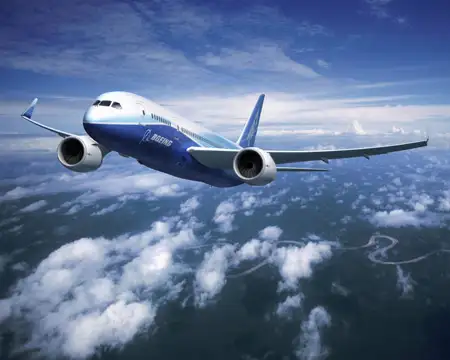
The travails of Boeing’s 787 Dreamliner have given rise to reams of news coverage, mostly devoted to reporting on the plane’s various electrical-system mishaps, and the subsequent investigations into the problems’ likely sources and solutions.
What has been left unexamined is why the problem occurred in the first place. Why, in other words, is a company with the vaunted engineering and manufacturing expertise of Boeing bedeviled by something as basic as a battery system?
In the February 4 edition of the New Yorker, business and finance writer James Surowiecki addresses the question head on. His findings, which cut to the very core of Boeing’s current business model, won’t be comforting to anyone concerned with the safety of Boeing’s products or the company’s financial prospects.
After giving the Dreamliner its due, dubbing it a “technological marvel” and “one of the coolest planes in the air,” Surowiecki proceeds to review Boeing’s recent history. Following the merger with McDonnell Douglas in 1997, the company’s corporate culture shifted from a willingness to place big bets on new products (the B747 being a prime example) to a risk-averse attitude in which innovation was stifled by the paralysis of analysis.
Under the new regime, the only way to get the proposed Dreamliner approved by Boeing’s top managers and board members was by distributing the risk among partner companies, all of which would be given responsibility for designing and manufacturing some of the new plane’s major components. To an unprecedented extent, Boeing became a consolidator of outsourced parts, building just 40 percent of the 787 itself.
And therein lies the problem with the Dreamliner, and with any complex product built according to the outsourcing model. According to Surowiecki, “the more complex a supply chain, the more chances there are for something to go wrong, and Boeing had far less control than it would have if more of the operation had been in-house.”
Working with 50 “strategic partners,” things did indeed go wrong, resulting in the Dreamliner’s rollout being delayed for three years. Those delays pushed the project billions over budget, which in turn ratcheted up the pressure to finalize the design and get production underway.
Fast forward to today, and all 50 of the Dreamliners so far delivered have been grounded by various countries’ regulatory agencies. There is no quick fix, and some of the affected airlines are thought to be demanding that Boeing compensate them for the revenue lost to cancelled flights.
Surowiecki sums up as follows: “Boeing is in a business where the margin of error is small. It shouldn’t have chosen a business model where the chance of making a serious mistake was so large.”
Boeing, in other words, bet small and, as a result, lost big.
Dreamliner Issues
The ever-growing list of 787-related incidents and regulatory responses now includes the following:
- On January 16, the FAA ordered all U.S. Dreamliners gounded until the safety issued could be sorted out. The move prompted a worldwide grounding.
- On January 15, All Nippon Airways and Japan Airlines suspended all 787 flights following a battery malfunction that resulted in an emergency landing.
- At least partly in response to the service suspensions by Japanese carriers, Qatar Airways cancelled a scheduled 787 flight from London to Doha.
- On January 13, a fuel leak was discovered on a Japan Airlines 787 at Tokyo’s Narita Airport.
- On January 11, the FAA announced that it would subject the 787 Dreamliner to an unusual post-launch “review.”
- On January 7, a fire broke out on a Japan Airlines 787 in Boston.
- A fire similar to the one in Boston had been reported during the 787’s testing phase in 2010.
- In December, an electrical malfunction forced a United Airlines 787 to make an emergency landing.
- Later that same month, United reported that the same issue had been discovered on a second Dreamliner.
- Also in December, Qatar Airlines grounded one of its 787s because of electrical issues.
- On December 5, the FAA ordered inspections of potential fuel-line leaks on all 787s.
About the 787 Dreamliner
The Dreamliner is Boeing’s most advanced airliner, featuring such cutting-edge technology as lithium-ion batteries and a composite-plastic body.
The first 787 was received by ANA in September 2011, and since then 50 787s have been delivered to eight airline customers, including United.
The company has taken orders for 844 Dreamliners, and Boeing hopes to sell as many as 5,000 during the lifetime of the plane.
Reader Reality Check
Are the 787’s problems of concern to you? Would you fly on one anyway?
This article originally appeared on FrequentFlier.com.
We hand-pick everything we recommend and select items through testing and reviews. Some products are sent to us free of charge with no incentive to offer a favorable review. We offer our unbiased opinions and do not accept compensation to review products. All items are in stock and prices are accurate at the time of publication. If you buy something through our links, we may earn a commission.
Related
Top Fares From
Today's Top Travel Deals
Brought to you by ShermansTravel
Kenya: 14-Night Tour, Incl. Tanzania &...
smarTours
 vacation
$7125+
vacation
$7125+
7-Night Caribbean Round-Trip Cruise From Orlando:...
Norwegian Cruise Line
 cruise
$739+
cruise
$739+
Ohio: Daily Car Rentals from Cincinnati
85OFF.com
 Car Rental
$19+
Car Rental
$19+



